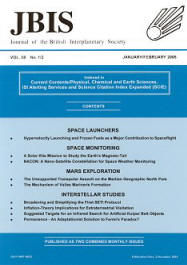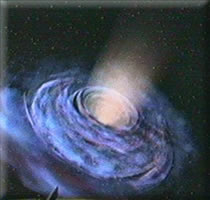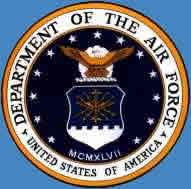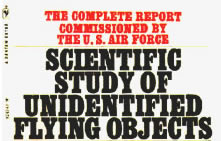Inflation - Theory Implications for Extraterrestrial Visitation
01.18.2005
 JBIS, Vol. 58, pp. 43-50, 2005 JBIS, Vol. 58, pp. 43-50, 2005
J. DEARDORFF1, B. HAISCH2, B. MACCABEE3 AND H.E. PUTHOFF4
1. 1689 S.W. Knollbrook Pl., Corvallis, Oregon 97333, USA.
2. National Aviation Reporting Center on Anomalous Phenomena
(NARCAP), Post Office Box 1535, Vallejo, California, USA.
3. Fund for UFO Research, Post Office Box 277, Mt Rainier,
Maryland, 20712, USA.
4. Institute for Advanced Studies at Austin, 4030 W. Braker Ln.,
Suite 300, Austin, Texas 78759, USA.
Email: puthoff.nul It has recently been argued that anthropic reasoning applied to
inflation theory reinforces the prediction that we should find
ourselves part of a large, galaxy-sized civilisation, thus
strengthening Fermi's paradox concerning "Where are they?"
Furthermore, superstring and M-brane theory allow for the
possibility of parallel universes, some of which in principle
could be habitable. In addition, discussion of such exotic
transport concepts as "traversable wormholes" now appears in the
rigorous physics literature. As a result, the "We are alone"
solution to Fermi's paradox, based on the constraints of earlier
20th century viewpoints, appears today to be inconsistent with
new developments in our best current physics and astrophysics
theories. Therefore we reexamine and reevaluate the present
assumption that extraterrestrials or their probes are not in the
vicinity of Earth, and argue instead that some evidence of their
presence might be found in certain high-quality UFO reports.
This study follows up on previous arguments that (1)
interstellar travel for advanced civilizations is not a priori
ruled out by physical principles and therefore may be
practicable, and (2) such advanced civilisations may value the
search for knowledge from uncontaminated species more than
direct, interspecies communication, thereby accounting for
apparent covertness regarding their presence.
Keywords: Fermi paradox, extraterrestrial hypothesis,
extraterrestrial visitation, UFO phenomenon, Condon Report, SETI
1. Introduction
 The ever recurring question of why Earth has seemingly not been visited by extraterrestrials (ETs) has received considerable discussion under the topic of 'Fermi's paradox'. The problem originated as a quip by Enrico Fermi to colleagues in Los Alamos over lunch one day in 1950. Whether one assumes the existence of only one other civilisation or of many alien civilisations in The ever recurring question of why Earth has seemingly not been visited by extraterrestrials (ETs) has received considerable discussion under the topic of 'Fermi's paradox'. The problem originated as a quip by Enrico Fermi to colleagues in Los Alamos over lunch one day in 1950. Whether one assumes the existence of only one other civilisation or of many alien civilisations in
our Milky Way galaxy, and whether one assumes colonisation involving interstellar travel at near-light speed or far below, diffusion modeling predicts colonisation or at least visitation
of all habitable planets in the galaxy on timescales of tens of millions of years, far less than the approximate 13 x 109 year age of the galaxy itself. Thus the paradox: Where are they [1]?
Theoretical possibilities unknown to Fermi make the paradox even
stronger today. One can now rationally conjecture about
prospects afforded by adjacent M-brane universes [2]. Indeed, if
the multidimensions underlying superstring and M-brane theory
are correct, there could be inhabited universes separated from
our own by minute, orthogonal distances. Also, anthropic
reasoning has recently been applied to inflation theory,
arriving once again at the conclusion that we should find
ourselves within an enormously larger galactic civilisation [3].
While the 'We are alone' solution to Fermi's paradox was once a
seemingly valid one, this answer is now incompatible with the
infinite universe and random self-sampling assumption consistent
with inflation theory. We thus find ourselves in the curious
position that current cosmological theory predicts that we
should be experiencing extraterrestrial visitation. At the same
time, current physics and astrophysics suggest that such
visitation may not be as impossible as had been thought.
2. Recent Scientific Advances
In recent astronomical discoveries, over 100 exoplanets have
been catalogued, with detection sensitivity now increased to the
point where, in one instance, a Jupiter-sized planet was deduced
to be in a Jupiter-like orbit around a Sol-like star [4]. In the
field of exobiology, much recent activity suggests that some of
the building blocks for life may originate in space as well as
be transported by meteorites [5- 6]. The possibility of
widespread panspermia has received new impetus [7-8]. These
findings and studies make plausible the hypothesis that there is
intelligent life elsewhere in the universe. This is, of course,
the fundamental assumption made by the proponents of SETI, the
Search for Extraterrestrial Intelligence using microwave or
optical means of detection.
The extraterrestrial hypothesis (ETH), that intelligent life
from 'elsewhere' in the universe could be visiting Earth, has
become less implausible through suggestions that the velocity-
of-light constraint=97 'they can't get here from there'=97is not as
restricting as had been assumed previously. This restriction has
its origin in the special theory of relativity, which we do not
question. However, within the context of general relativity (GR)
there are three approaches which may permit legitimately
bypassing this limit, given sufficiently advanced (perhaps by
millions of years!) knowledge of physics and technology.
 One approach popularised by Thorne and Sagan concerns the One approach popularised by Thorne and Sagan concerns the
possibility of wormholes, or cosmic subways, a form of shortcut
through the space-time metric [9]. Using the standard GR as a
basis, certain mathematical requirements for traversable
wormholes have been derived and published in the scientific
literature and it appears that there is the possibility of
engineering a wormhole metric, at least in principle [10].
A second more recent approach published in the GR literature has
been dubbed the 'Alcubierre Warp Drive' [11-12]. Unlike the
speed of light limit through space, there is no limit to the
speed at which space itself might stretch. Faster than light
(FTL) relative motion is part of inflation theory, and
presumably the universe beyond the Hubble distance is receding
from us faster than c. It was shown that a spaceship contained
in a volume of Minkowski space could in principle make use of
FTL expansion of space-time behind and a similar contraction in
front, with the inconvenience of time dilation and untoward
accelerations being overcome. A related approach involves
constructing a 'Krasnikov tube' [13] to connect spatially remote
locales. Of course so-called exotic matter would be required for
either case.
If GR itself were to be reinterpreted in terms of a polarisable
vacuum as first proposed by Dicke [14], this would open the
possibility of a different type of metric engineering in which
the dielectric properties of the vacuum might be altered in such
a way as to raise the local propagation velocity of light. In
effect one would be creating a local index of refraction of less
than unity [15].
Finally, there is the conjectured possibility of making use of
the additional dimensionalities of M-brane and superstring
theory to transfer into adjacent universes where the speed of
light limit may be quite different and reentering our universe
at the desired location. This is by far the most speculative
possibility.
Clearly when it comes to engineering warp drive or wormhole
solutions, seemingly insurmountable obstacles emerge, such as
unattainable energy requirements [16] or the need for exotic
matter [17]. Thus, if success is to be achieved, it must rest on
some yet unforeseen breakthrough about which we can only
speculate, such as a technology to cohere otherwise random
vacuum fluctuations [18]. Nonetheless, the possibility of
reduced-time interstellar travel by advanced extraterrestrial
(ET) civilisations is not, as naive consideration might hold,
fundamentally ruled out by presently known physical principles.
ET knowledge of the physical universe may comprise new
principles which allow some form of FTL travel. This possibility
is to be taken seriously, since the average age of suitable
stars within the 'galactic habitable zone', in which the Earth
also resides, is found to be about 109 years older than the sun
[19] suggesting the possibility of civilizations extremely
advanced beyond our own.
There are further reasons why the 'We are alone' solution to
Fermi's paradox should perhaps be set aside in favor of the ETH.
A previously preferred solution, that biogenesis is an
exceedingly rare event in conjunction with both panspermia and
interstellar travel being inoperative [1], is now scarcely
tenable in light of the cosmological considerations already
discussed. The ETH appears to be the most viable remaining
solution, where 'ET' is taken in a general non-Earthly sense
that could include extra-dimensional realms, as in M-brane and
superstring theory. Given the highly advanced ET science and
technology to be expected in considerably older civilisations,
coupled with the many observational reports since WWII of highly
advanced technology seemingly operating at will within Earth's
skies, it is only logical to search for evidence of ET
visitations in at least a fraction of the ongoing, unexplainable
reports popularly referred to as 'UFO sightings.' Reluctance to
do so could result in our failure to realize that observations
of 'genuine' ET visitations have been occurring. This approach,
which we follow here, explores the likelihood that 'we actually
do belong to a large civilisation but are unaware of that fact'
[3].
3. U.S. Air Force Response (1947-1969)
 Reports of unknown objects in the skies, appearing as some sort of flying craft and exhibiting extraordinary manoeuvres, first became known to the general Reports of unknown objects in the skies, appearing as some sort of flying craft and exhibiting extraordinary manoeuvres, first became known to the general
public in 1947. The first publicised sighting occurred on June 24 of that year, after which there were many
hundreds of sightings during the following months. The phenomenon has been continuing ever since
[20-24].
At first the U.S. Air Force collected the sighting reports for
analysis in its operation Project Sign (1948-1949). This was
succeeded by Project Grudge (1949-1952) and then Project Blue
Book (1952-1969) [20,25] . Some 20% of Project Blue Book's
sightings from 1953-1965 were left unexplained, if their
'insufficient data' category is included [22]. The Battelle
Memorial Institute (BMI; Columbus, Ohio) discovered, in their
study of 3,201 reports from 1947 through 1952, that the
percentage of unknowns (unexplainable sightings) increased with
increasing quality of the sighting information and reliability
of the observers [21]. A surprisingly high percentage, 30%, of
the civilian sightings, and an even more surprising 38%, of the
military sightings rated as excellent in quality were listed as
unknown. On the other hand, only about 15% of the civilian and
20% of the military sightings rated as poor were unknown. The
increase in the percentage of unknowns with increasing quality
of the report is an unexpected result if sightings were all
explainable as mistakes (failure to correctly identify the
sighted phenomenon) by either the observer(s) or the scientists
who analysed the sightings. In this collection of 3,201
sightings none were listed as hoaxes and only 1.5% were listed
as caused by psychological effects. This result discovered
during the several year long BMI study refutes the claim, made
in the Condon Report [22], that UFO reports are from 'less well
informed individuals,' who are 'not necessarily reliable.' It is
worthy of note that Condon had access to the results of the BMI
study but there is no reference to it in the Condon Report.
Project Blue Book culminated in 1969 with the government
sponsored Condon Report [22]. In the opening section of the
Report its director concluded that, after years of
investigation, the U.S. Air Force had found nothing truly
new=97nothing that supported claims of new physics or the ETH=97and
that continued investigation probably would not find anything
truly new in the future. The Report recommended that the Air
Force end its investigation project, which it did in late 1969.
4. The Condon Report (1968)
 In the late 1960's, the U.S. Air Force issued a contract to the In the late 1960's, the U.S. Air Force issued a contract to the
University of Colorado to carry out a scientific study of
evidence concerning the UFO phenomenon. The director of the
project was Prof. Edward U. Condon, a distinguished and
influential physicist who made no secret of his opinion even at
the outset that no substantive evidence for extraterrestrial
visitation was liable to result. The study was relatively brief
(2 years) and had a notably low budget (app. $500K) for a
serious scientific study. When the Condon Report was released in
1968, the American scientific community accepted its apparently
negative conclusion concerning evidence for extraterrestrial
visitation in a generally uncritical way, and to some extent
even an enthusiastic way since it offered an end to a
troublesome situation. An endorsement of the Report by the
National Academy of Sciences took place following an unusually
rapid review and the Air Force quickly used the Report as a
justification to terminate any further public involvement with
the topic.
The negative conclusion of the Report is more apparent than real
however, since there is a substantial discrepancy between the
conclusion in the "Summary of the Study" written by Condon
singlehandedly, and the conclusion one could reasonably draw
from the evidence presented in the main body of the Report. Such
a dichotomy was possible because the study was a project for
which the director, Condon, had sole authority; it was not the
work of a committee whose members would have to reach some
consensus conclusion. An analysis of the Condon Report by
Sturrock [26] details the many disagreements between Condon's
dismissive summary and the actual data.
Given the thousand-page length of the Report, one can safely
assume that very few in the scientific community would have
devoted the time necessary to read the entire document. The
impact of the Report was thus largely due to Condon's leveraging
his prestigious scientific reputation into an acceptance of his
own personal views as representing the apparent outcome of a
scientific investigation. Indeed, as Sturrock documents, Condon
actually took no part in the investigations and indicated the
conclusion he intended to draw well before the data were
properly examined, hardly a scientific approach.
The portion of the Condon Report that contains its sighting
analyses does not support the "Summary of the Study" written by
Condon [26]. Many of the events presented within its Case
Studies section do fall into the 'unidentified' category of
UFOs, for which the Report's definition was, in essence: 'A
puzzling stimulus for a report of something seen in the sky or
landed on the earth that could not be identified as having an
ordinary natural origin.' In a detailed review of this Report,
however, it was noted that 'The sheer bulk of the report, much
of it "scientific padding", cannot conceal from anyone who
studies it closely that it examines only a tiny fraction of the
really puzzling UFO reports, and that its scientific
argumentation is often unsatisfactory. Of roughly ninety cases
that it specifically confronts, more than thirty are conceded to
be unexplained' [27]. Four of the cases, reanalysed and reported
in detail at the 1969 AAAS Symposium, disclosed how unscientific
the Condon Report's treatment of them had been; the reanalyses
have since gone unrefuted. Hence we cannot agree with the Condon
Report's assertion that the phenomenon provides no new subjects
for science to explore, given that many sightings were left
unexplained. Furthermore, in many of the cases that the Report
claimed to have identified, that goal was achieved merely
through assuming that the witnesses had seen something differing
in detail from what they had reported. Also, a committee of the
American Institute of Aeronautics and Astronautics in 1971 found
'it difficult to ignore the small residue of well-documented but
unexplainable cases that form the hard core of the UFO
controversy'[28]. Clearly, the Condon Report was left in an
unsatisfactory state [20,24-26,29-30].
The primary conclusion of the Condon panel sidestepped the main
issue, the failure to explain every sighting, by saying: 'The
evidence presented on Unidentified Flying Objects shows no
indication that these phenomena constitute a direct physical
threat to national security' [22]. This is not inconsistent,
however, with some fraction of unexplained reports representing
actual ET visitations.
Part 2 | -->
|

